-
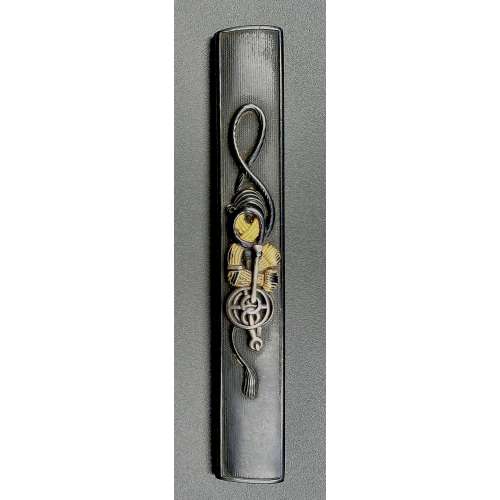 A shakudō kozuka decorated with equestrian tack inlaid in raven black shakudō, gold uttori and a silver alloy on a nanako ground. Unsigned. Attributed to Goto Joshin (Japanese, 1513 – 1562), 3rd generation Goto master. Late Muromachi period, Tenbun era (c. 1550). Size: 96.7 x 14.4 x 4.9 mm. Tokubetsu Hozon certificate № 2004230 issued by NBTHK on May 10, 2017. For a detailed explanation of terms see: Sesko, Markus. Handbook: Of Sword Fittings Related Terms. Germany: Books on Demand, 2011.
A shakudō kozuka decorated with equestrian tack inlaid in raven black shakudō, gold uttori and a silver alloy on a nanako ground. Unsigned. Attributed to Goto Joshin (Japanese, 1513 – 1562), 3rd generation Goto master. Late Muromachi period, Tenbun era (c. 1550). Size: 96.7 x 14.4 x 4.9 mm. Tokubetsu Hozon certificate № 2004230 issued by NBTHK on May 10, 2017. For a detailed explanation of terms see: Sesko, Markus. Handbook: Of Sword Fittings Related Terms. Germany: Books on Demand, 2011. -

Iron tsuba of round form with dam-shaped rim (dote-mimi) pierced with hitsu-ana and two udenuki-ana (probably cut later on) decorated in flat inlay (hira-zōgan) with vines and symbols of thunder or lightning (possibly - family crest, mon). Hitsu-ana and nakago-ana with copper sekigane.
Ōnin or Heianjō school, or, possibly Kaga or Umetada school. Momoyama period or earlier (Muromachi), 16th century. Unsigned.Size: 64.5 x 63.8 x 2.2 (center), 4.2 (rim) mm.
Provenance: Lundgren Collection: [Japanese sword-fittings and metalwork in the Lundgren Collection. Published by Otsuka Kogeisha Co., Ltd., Tokyo 1992], №31; The Lundgren Collection of Japanese Swords, Sword Fittings and A Group of Miochin School Metalwork. Christie's Auction: Tuesday, 18 November 1997, London. Sales "GOTO-5881". Christie's, 1997, №2. Lundgren's description at Christie's: Heianjo tsuba. Unsigned. The circular plate decorated in brass hirazogan with flowers, plants and symbols of thunder, dote mimi and udenuki ana, late Muromachi period (16th century). Tokyo 1992 description: Sword guard with design of flowering plants and frets in inlay. Unsigned. Heianjo inlay school. 6.35 x 6.3 cm, thickness of rim 0.40 cm. Iron. Flat brass inlay. Muromachi-Momoyama Period, 16th century. Provenance: The Second John Harding. A somewhat look-a-like pieces can be found in various catalogues. The one in Naunton Collection, №172, is signed: Umetada of Yamashiro: "Iron, small, almost circular, with raised oval rim, inlaid all over with leaves and scrolls in brass hirazōgan." -
 Iron tsuba of a spindle shape (tate-itomaki-gata) pierced and inlaid in brass suemon-zōgan with bellflowers, vines and foliage, and a dragonfly in the upper right corner, on both sides. One of the hitsu-ana plugged with grey metal (led or pewter), nakaga-ana fitted with copper sekigane. The shape of the tsuba may be interpreted as four saddles connected to each other by horse bits. Such a design of sukashi and zōgan is usually attributed to Kaga Yoshirō branch of Heianjo school, active in the second half of the 17th century (c. 1650-1700). Size: 95.9 mm diagonal; 4.1 mm thickness. Tokubetsu Kicho certificate № 332 issued by NBTHK on October 12, 1965.
Iron tsuba of a spindle shape (tate-itomaki-gata) pierced and inlaid in brass suemon-zōgan with bellflowers, vines and foliage, and a dragonfly in the upper right corner, on both sides. One of the hitsu-ana plugged with grey metal (led or pewter), nakaga-ana fitted with copper sekigane. The shape of the tsuba may be interpreted as four saddles connected to each other by horse bits. Such a design of sukashi and zōgan is usually attributed to Kaga Yoshirō branch of Heianjo school, active in the second half of the 17th century (c. 1650-1700). Size: 95.9 mm diagonal; 4.1 mm thickness. Tokubetsu Kicho certificate № 332 issued by NBTHK on October 12, 1965. -

Iron tsuba of round form pierced (sukashi) in a chessboard fashion and decorated with linear (sen-zōgan) and cast (suemon-zōgan) brass inlay, including symbols of the swastika, flower-lozenge, maple leaf, pine needle, etc. on both sides; rim and openings outlined with brass inlay. Nakagō-ana plugged with copper fittings (sekigane).
Momoyama period. End of the 16th - beginning of the 17th century. Dimensions: Diameter: 75.5; Thickness: 4.5 mm. -
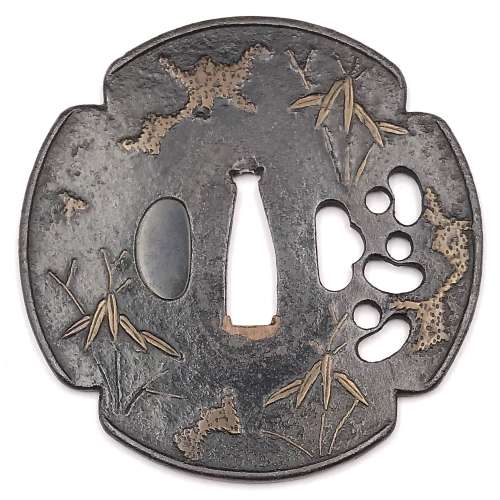 Iron tsuba of four-lobbed mokkō form (possibly it was circular and then altered to produce the mokkō) with slightly raised rim decorated with three kukurizaru ('tied up monkey' toy) in openwork (sukashi) next to kogai-hitsu-ana; inlaid in red-ish copper (suaka) with the design of bamboo stems and leaves, and shapeless masses which most probably represent snow. Kozuka-hitsu-ana plugged with shakudo. Probably original kogai-hitsu-ana. Copper sekigane. Surface still covered with lacquer (urushi). Late Muromachi period (1514-1573). Size: 86.1 x 85.8 x 2.6 mm NBTHK Certificate №4002543: Hozon - "Worthy of preservation" (Attribution: Mumei Heianjō Zōgan)
Iron tsuba of four-lobbed mokkō form (possibly it was circular and then altered to produce the mokkō) with slightly raised rim decorated with three kukurizaru ('tied up monkey' toy) in openwork (sukashi) next to kogai-hitsu-ana; inlaid in red-ish copper (suaka) with the design of bamboo stems and leaves, and shapeless masses which most probably represent snow. Kozuka-hitsu-ana plugged with shakudo. Probably original kogai-hitsu-ana. Copper sekigane. Surface still covered with lacquer (urushi). Late Muromachi period (1514-1573). Size: 86.1 x 85.8 x 2.6 mm NBTHK Certificate №4002543: Hozon - "Worthy of preservation" (Attribution: Mumei Heianjō Zōgan) -
 Iron tsuba of round form with two ebi (lobster) on omote (obverse side) and shika (deer) among scattered momiji (maple leaves) on ura (reverse side) motif in brass takabori (high relief) suemon-zōgan. Traces of lacquer. Unsigned. Late Muromachi / Momoyama period (late 16th / Early 17th century). Dimensions: 69.0.6 mm (H) x 69.6 mm (W) x 3.4 mm (T, seppa-dai). Weight: 92.6 g. Illustrated at: The Lundgren Collection of Japanese Swords, Sword Fittings and A Group of Miochin School Metalwork. Christie's Auction: Tuesday, 18 November 1997, London. Sales "GOTO-5881". Christie's, 1997. - #2 at page 7. Provenance: The second John Harding; The Lundgren Collection. Description at Christie's: "The iron plate depicting two lobsters in takabory and brass takazogan, the reverse similarly decorated with deer among scattered maple leaves, square mimi, late Muromachi / early Momoyama period (late 16th/early 17th century) Diameter 68 mm, mimi thickness 4 mm. Provenance: The second John Harding." Also at: JAPANESE SWORD-FITTINGS & METALWORK IN THE LUNDGREN COLLECTION. Published by Otsuka Kogeisha, Tokyo 1992. № 134. Description on page 173: Sword guard with design of shrimps in inlay (scarlet [sic] maple leaves and deer on the reverse side). Unsigned. Heianjō inlay school. Vertical 6.85 cm, horizontal 6.90 cm, Th. of rim 0.40 cm. Iron. Taka-bori relief and brass inlay. Momoyama period, 16th - 17th century. According to Merrily Baird, maple leaves, especially if paired with the deer, allude to autumnal tradition of Japanese aristocracy of viewing the seasonal changes of color in the Nara area. The lobster is typical Japanese ebi, - it lacks prominent claws, and has a spiny shell. As a symbol of longevity and good fortune, lobster is a staple of New Year's decoration.
Iron tsuba of round form with two ebi (lobster) on omote (obverse side) and shika (deer) among scattered momiji (maple leaves) on ura (reverse side) motif in brass takabori (high relief) suemon-zōgan. Traces of lacquer. Unsigned. Late Muromachi / Momoyama period (late 16th / Early 17th century). Dimensions: 69.0.6 mm (H) x 69.6 mm (W) x 3.4 mm (T, seppa-dai). Weight: 92.6 g. Illustrated at: The Lundgren Collection of Japanese Swords, Sword Fittings and A Group of Miochin School Metalwork. Christie's Auction: Tuesday, 18 November 1997, London. Sales "GOTO-5881". Christie's, 1997. - #2 at page 7. Provenance: The second John Harding; The Lundgren Collection. Description at Christie's: "The iron plate depicting two lobsters in takabory and brass takazogan, the reverse similarly decorated with deer among scattered maple leaves, square mimi, late Muromachi / early Momoyama period (late 16th/early 17th century) Diameter 68 mm, mimi thickness 4 mm. Provenance: The second John Harding." Also at: JAPANESE SWORD-FITTINGS & METALWORK IN THE LUNDGREN COLLECTION. Published by Otsuka Kogeisha, Tokyo 1992. № 134. Description on page 173: Sword guard with design of shrimps in inlay (scarlet [sic] maple leaves and deer on the reverse side). Unsigned. Heianjō inlay school. Vertical 6.85 cm, horizontal 6.90 cm, Th. of rim 0.40 cm. Iron. Taka-bori relief and brass inlay. Momoyama period, 16th - 17th century. According to Merrily Baird, maple leaves, especially if paired with the deer, allude to autumnal tradition of Japanese aristocracy of viewing the seasonal changes of color in the Nara area. The lobster is typical Japanese ebi, - it lacks prominent claws, and has a spiny shell. As a symbol of longevity and good fortune, lobster is a staple of New Year's decoration. -
 Relatively thick iron tsuba of rounded square form with slightly elevated rim decorated in carving (sukidashi-bori) and yellow brass (shinchū) inlay (suemon-zōgan) with legendary creatures (humans with cow heads) in a pine tree forrest on the face, and a horned man with a stick hunting a rabbit in the woods on the reverse. Large hitsu-ana possibly cut off later on. In the beginning of the 20th century such tsuba were usually attributed to Fushimi-Kaga school. This one may be attributed to either Ōnin or to Heianjō. The latter seems most plosible because of the thick web and dull patina. The technique may also be called "shinchū-zōgan". Momoyama or early Edo period. Unsigned. Dimensions: 72.3 x 68.4 x 4.1 mm
Relatively thick iron tsuba of rounded square form with slightly elevated rim decorated in carving (sukidashi-bori) and yellow brass (shinchū) inlay (suemon-zōgan) with legendary creatures (humans with cow heads) in a pine tree forrest on the face, and a horned man with a stick hunting a rabbit in the woods on the reverse. Large hitsu-ana possibly cut off later on. In the beginning of the 20th century such tsuba were usually attributed to Fushimi-Kaga school. This one may be attributed to either Ōnin or to Heianjō. The latter seems most plosible because of the thick web and dull patina. The technique may also be called "shinchū-zōgan". Momoyama or early Edo period. Unsigned. Dimensions: 72.3 x 68.4 x 4.1 mm -
 Iron tsuba of almost round form with a brass outlined circular opening (sukashi) in the bottom adorned with the Myriad Treasures [takaramono, 宝物] and winter motifs inlaid in cast brass (suemon-zōgan); hitsu-ana possibly cut later, both plugged with shakudo, nakaga-ana fitted with copper sekigane. According to Merrily Baird*) (2001), the symbolism of Myriad Treasures “is associated with the Seven Gods of Good Luck, who carry them in a sack”. Among the treasures, which are said to ensure prosperity, long life, and general good fortunes, are (reading clockwise from the top):
Iron tsuba of almost round form with a brass outlined circular opening (sukashi) in the bottom adorned with the Myriad Treasures [takaramono, 宝物] and winter motifs inlaid in cast brass (suemon-zōgan); hitsu-ana possibly cut later, both plugged with shakudo, nakaga-ana fitted with copper sekigane. According to Merrily Baird*) (2001), the symbolism of Myriad Treasures “is associated with the Seven Gods of Good Luck, who carry them in a sack”. Among the treasures, which are said to ensure prosperity, long life, and general good fortunes, are (reading clockwise from the top):- Sake set [shuki, 酒器], namely flask, ladle, and cups
- Cloves [choji, 丁子]
- Purse of inexhaustible reaches [kinchaku, 巾着]
- Magic mallet [kozuchi, 小槌]
- Key to the storehouse of the Gods [kagi, 鍵]
- Rhombus, or Lozenge (hosho, 方勝), with the second ideograph meaning victory.
- Sacred (or wish-granting) gem, or jewel [hōju, 宝珠]
- Hats of invisibility [kakuregasa, 隠れ笠]
-
 Large and thin iron tsuba of round form (width > height) decorated with the design of a tiger sheltering in bamboo in suemon-zōgan brass inlay. A fragment of tail inlay is missing. Bamboo leaves on the reverse. According to Merrily Baird [Symbols, p. 166], tiger sheltering in bamboo symbolizes "weak giving shelter to the strong". Momoyama period. Unsigned. Dimensions: 90.8 x 91.2 x 3.4 (center), 3.1 (rim) mm. Custom wooden box. NBTHK Certificate № 4001593.
Large and thin iron tsuba of round form (width > height) decorated with the design of a tiger sheltering in bamboo in suemon-zōgan brass inlay. A fragment of tail inlay is missing. Bamboo leaves on the reverse. According to Merrily Baird [Symbols, p. 166], tiger sheltering in bamboo symbolizes "weak giving shelter to the strong". Momoyama period. Unsigned. Dimensions: 90.8 x 91.2 x 3.4 (center), 3.1 (rim) mm. Custom wooden box. NBTHK Certificate № 4001593. -
 Heianjō tsuba, carved and inlayed in brass with a somewhat primitive design of rocks, plants, and waves, and a man in a boat beside two jakugo stone baskets on the face and a religious structure (stupa, grave stone) on the reverse. Muromachi or Momoyama period.
Heianjō tsuba, carved and inlayed in brass with a somewhat primitive design of rocks, plants, and waves, and a man in a boat beside two jakugo stone baskets on the face and a religious structure (stupa, grave stone) on the reverse. Muromachi or Momoyama period.Size: 83.2 x 82.4 x 3.6 mm; 149.2 g
The Carlo Monzino Collection of Japanese sword fittings and swords (Sotheby's, London, 18 June 1996. p. 12-13) №9 provides an illustration of the similar tsuba with the following description: Heianjo tsuba, carved and inlayed with rocks, plants, and waves, also pierced with a jakago [sic] (stone basket).
Gary D. Murtha in his Japanese sword guards Onin - Heianjo - Yoshiro (GDM Publications, 2016) on page 53 shows a look-a-like tsuba (though, with a kogai-hitsu-ana) with the follwoing description: Iron, 77 mm, tsuba with brass tree, snake, jakugo baskets, and curved brass pieces (representing water flowing over rocks). Buddhist halo to reverse. Although showing Onin traits, a Shoami Heiamjo attribution would fit better. Azuchi-Momoyama period.

-

Iron tsuba of round form pierced (sukashi) and inlaid in flat (hira-zōgan) and cast brass (suemon-zōgan), details carved in kebori, with design of two phoenixes, bamboo, and paulownia leaves and flowers (kiri-mon) on both sides. According to seller: Bizen-Yoshirō school (or Heianjō school). Unsigned.
Momoyama period. End of the 16th - beginning of the 17th century. Dimensions: Diameter: 99.5 mm; Thickness: 2.1 mm at centre; 4.3 mm at the rim. According to Merrily Baird (Symbols of Japan), "bamboo teamed with paulownia blossoms or with paulownia and the phoenix, in reference to the Chinese legend that the phoenix perches only on the paulownia and eats only the bamboo". Citation from http://www.clevelandart.org/art/1986.2.1: "The immense heraldic birds on display [...] reflect the Momoyama era's spirit of newly gained self-confidence and an affinity for grand expressive statements in painting, architecture, the textile and ceramic arts, as well as garden design. While that period preceded the arrival of prosperity, it clearly marked an extraordinary moment in Japanese cultural history, one frequently compared with the twelfth century of the Heian period. [...] Rather than an emblem of immortality, as it is in Western lore, in Japan, the phoenix evolved out of its origins in Chinese mythology to become, by the sixteenth century, an auspicious symbol of political authority. Together with clusters of the distinctively shaped paulownia leaves, this long-tailed, mythical bird [...] proclaiming an air of graceful command". -
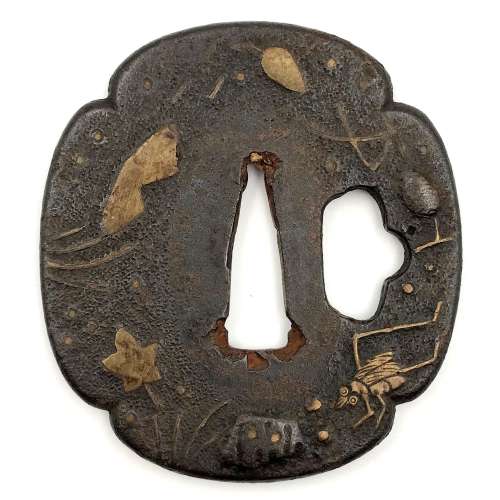 Iron tsuba of four-lobbed mokkō form decorated in brass and shakudō inlay on the face with design of rotten skull, fly, maple leaf, pine cones and needles, and on the back with design of rotten skull, wild boar, pine cones and needles. Scattered brass dots on both sides. Hitsu-ana possibly cut off later. Surface has traces of lacquer (urushi). Momoyama period. Dimensions: 67.3 x 61.5 x 4.3 mm A similar example can be found at Tsuba Kanshoki by Kazutaro Torogoye, 1975 on p. 61: "Heianjōzōgan tsuba. No sig. Iron: Pine-cone, seeds, ants & rock, brass zōgan. Kakumimi: C. 1.5 bu. Age: Momoyama. Sup. - Early work. Interest."
Iron tsuba of four-lobbed mokkō form decorated in brass and shakudō inlay on the face with design of rotten skull, fly, maple leaf, pine cones and needles, and on the back with design of rotten skull, wild boar, pine cones and needles. Scattered brass dots on both sides. Hitsu-ana possibly cut off later. Surface has traces of lacquer (urushi). Momoyama period. Dimensions: 67.3 x 61.5 x 4.3 mm A similar example can be found at Tsuba Kanshoki by Kazutaro Torogoye, 1975 on p. 61: "Heianjōzōgan tsuba. No sig. Iron: Pine-cone, seeds, ants & rock, brass zōgan. Kakumimi: C. 1.5 bu. Age: Momoyama. Sup. - Early work. Interest."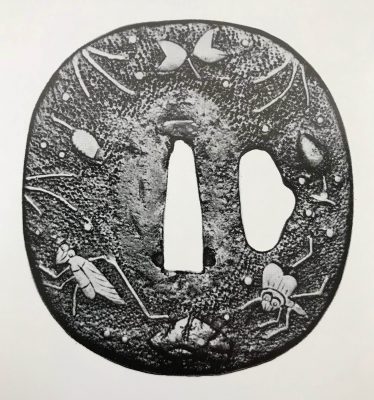
Tsuba Kanshoki, 1975, p. 61: Heianjō tsuba, Momoyama Period.
-

Iron tsuba of mokkō form (mokkōgata) pierced (sukashi) and inlaid with precast dark brass inlay (taka-zōgan) with somewhat abstract/geometrical design that can be liberally described as pines, mist, and snow.
Momoyama or early Edo period. End of the 16th - beginning of the 17th century. Heianjō school. Unsigned. Dimensions: 86.8 x 82.9 x 4.5 mm. -
 Iron tsuba with design of a cricket and grass inlaid in brass (suemon-zōgan) and a bridge over a stream in openwork (sukashi) on both sides. Inlay of distant part of the cricket's antenna is missing. Heianjō School. Momoyama period. Diameter: 79.5 mm, thickness at seppa-dai: 3.3 mm NBTHK # 4002100.
Iron tsuba with design of a cricket and grass inlaid in brass (suemon-zōgan) and a bridge over a stream in openwork (sukashi) on both sides. Inlay of distant part of the cricket's antenna is missing. Heianjō School. Momoyama period. Diameter: 79.5 mm, thickness at seppa-dai: 3.3 mm NBTHK # 4002100. -
 Iron tsuba of otafuku-gata form decorated on the face with death and autumn motifs: autumnal grasses and flowers in yellow brass and shakudō, skull, limb bone and sternum inlaid in shakudō. On the reverse the plate is inlaid in red copper with a chrysanthemum and maple leaves floating in stylized water streams. "Plants floating atop water form common motifs, as occurs with chrysanthemums, maple leaves, and cherry blossoms, in particular." [Merrily Baird]. Such plants may be used as a family crest (mon), or may be just a reminder of a floating nature of life. Momoyama period, late 15th century. Dimensions: 75.3 x 69.9 x 4.3 mm.
Iron tsuba of otafuku-gata form decorated on the face with death and autumn motifs: autumnal grasses and flowers in yellow brass and shakudō, skull, limb bone and sternum inlaid in shakudō. On the reverse the plate is inlaid in red copper with a chrysanthemum and maple leaves floating in stylized water streams. "Plants floating atop water form common motifs, as occurs with chrysanthemums, maple leaves, and cherry blossoms, in particular." [Merrily Baird]. Such plants may be used as a family crest (mon), or may be just a reminder of a floating nature of life. Momoyama period, late 15th century. Dimensions: 75.3 x 69.9 x 4.3 mm. -
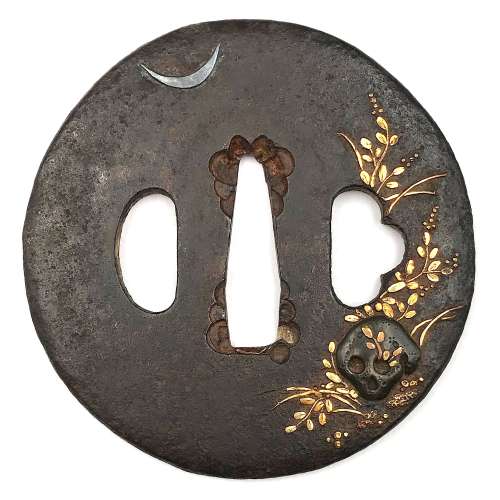 An iron tsuba of round shape inlaid with shakudō, gold, and silver with a motif of a weather-beaten (nozarashi) skull and grasses growing beside as well as through the eye-pit, and a crescent moon above the scene. Grasses on the reverse. Unsigned. Dimensions: 71.7 x 70.6 x 4.2 mm Reference: Skull, bones and grave markers SOLD
An iron tsuba of round shape inlaid with shakudō, gold, and silver with a motif of a weather-beaten (nozarashi) skull and grasses growing beside as well as through the eye-pit, and a crescent moon above the scene. Grasses on the reverse. Unsigned. Dimensions: 71.7 x 70.6 x 4.2 mm Reference: Skull, bones and grave markers SOLD -
 Iron tsuba of a round form (maru-gata) pierced (sukashi) with two six-petal flowers at 6 and 12 o’clock and modified lozenges at 3 and 9 o’clock, and inlaid in brass (suemon-zōgan) with tendrils and flowers (chrysanthemum, cherry blossom, Chinese bellflower, paulownia); openings outlined with scalloped brass wire. The plate is slightly concave with traces of lacquer on the surface. Nakago-ana plugged with copper sekigane. Some elements of inlay missing. The rim with conspicuous tekkotsu, quite worn. Measurements: Height 92.0 mm; Width 86.3 mm; thickness at seppa-dai 3.2 mm, at rim 4.2 mm. Time: Late Muromachi (1514 – 1573) or earlier.
Iron tsuba of a round form (maru-gata) pierced (sukashi) with two six-petal flowers at 6 and 12 o’clock and modified lozenges at 3 and 9 o’clock, and inlaid in brass (suemon-zōgan) with tendrils and flowers (chrysanthemum, cherry blossom, Chinese bellflower, paulownia); openings outlined with scalloped brass wire. The plate is slightly concave with traces of lacquer on the surface. Nakago-ana plugged with copper sekigane. Some elements of inlay missing. The rim with conspicuous tekkotsu, quite worn. Measurements: Height 92.0 mm; Width 86.3 mm; thickness at seppa-dai 3.2 mm, at rim 4.2 mm. Time: Late Muromachi (1514 – 1573) or earlier. -
 Iron tsuba of slightly elongated round form (nagamaru-gata) pierced on top and in the bottom (ko-sukashi) with simplified Genji-kō (incense game symbol) and two petals of bellflower; openings, seppa-dai, and plate along the rim are outlined with brass wire, kozuka-ana outlined with scalloped brass wire, missing on the front; kogai-ana pierced later. The plate is slightly concave with traces of lacquer, decorated in brass (suemon-zōgan) with tendrils, bellflowers, and Genji characters, and with brass dots (ten-zogan), many of which are missing. Measurements: Height 77.5 mm; Width 75.5 mm; thickness at seppa-dai 2.4 mm, at rim 3.2 mm. Time: Late Muromachi (1514 – 1573) or earlier.
Iron tsuba of slightly elongated round form (nagamaru-gata) pierced on top and in the bottom (ko-sukashi) with simplified Genji-kō (incense game symbol) and two petals of bellflower; openings, seppa-dai, and plate along the rim are outlined with brass wire, kozuka-ana outlined with scalloped brass wire, missing on the front; kogai-ana pierced later. The plate is slightly concave with traces of lacquer, decorated in brass (suemon-zōgan) with tendrils, bellflowers, and Genji characters, and with brass dots (ten-zogan), many of which are missing. Measurements: Height 77.5 mm; Width 75.5 mm; thickness at seppa-dai 2.4 mm, at rim 3.2 mm. Time: Late Muromachi (1514 – 1573) or earlier.


